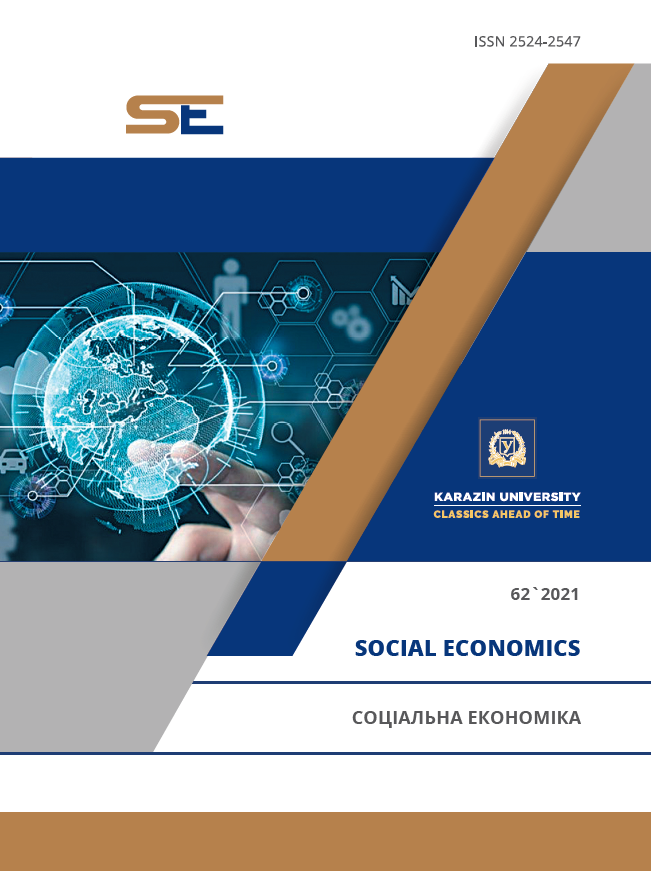CURRENT STATE AND INNOVATIVE DIRECTIONS OF PAYMENT SYSTEMS DEVELOPMENT IN UKRAINE
Abstract
The rapid development of technologies, their impact on the speed of decision-making, and changes in communication methods have a significant impact on the financial sector, namely on payment systems. In addition to the technological transformation of the payment systems themselves, these changes are transforming the requirements of users who want transfers to be faster, safer, and more reliable. On the international market, the processes of change began several years ago, now they have begun to take place in Ukraine as well. This actualizes the need to assess the current state of the payment system in Ukraine, as well as to study those technologies that have the greatest prospects and significant impact on the payment space. For this purpose, in this study, we assessed the current state and trends in the functioning of the payment system of Ukraine. We investigated its main participants, such as the System of Electronic Payments of the National Bank of Ukraine (SEP), PROSTIR National Payment System, the dynamics of the main indicators. This made it possible to identify and substantiate the main problems and obstacles to the development of the payment system of Ukraine. Among the main ones, we attributed: monopolization of the payment market by international payment systems (IPS), insufficient level of consumer protection and shortcomings of legislation on market regulation, insufficient level of payment and financial literacy, especially of certain categories of the population (pensioners). An overview of the main trends in the development of payment systems under the influence of digitalization and innovation made it possible to identify the most significant technologies. Namely, real-time payments (RTP), SWIFT gpi, artificial intelligence, and machine learning, blockchain, and distributed ledger technology (DLT). In our opinion, these innovations themselves will make payment systems safer, more efficient, transparent, and cost-effective. But it is worth noting that the implementation of technologies is impossible without the complete digitalization of all payments and related services. Therefore, the main direction of increasing the efficiency of the functioning of the payment system of Ukraine is the transfer of the majority of payments to digital format. We believe this can be realized through high-quality coordination of all participants in the payment market, clear and timely implementation of the roadmap for changes, ensuring free and easy access to payment services for all users (financial inclusion), increasing the payment literacy of the population, creating conditions for expanding the payment infrastructure.
Downloads
References
Yevdokymova, M. (2020). Ukrainian payment system functioning mechanism and major development problems. Scientific opinion: Economics and Management, 3(69). doi: https://doi.org/10.32836/2521-666x/2020-69-17. (in Ukrainian)
Sodoma, R., Ahres, O., & Shmatkovska, T. (2020). Payment systems in the conditions of digitalization. Vìsnik Lʹvìvsʹkogo nacìonalʹnogo agrarnogo unìversitetu. Ekonomìka APK, 27, 87–91. doi: https://doi.org/10.31734/economics2020.27.087. (in Ukrainian)
Trusova, N. V., & Chkan, I. O. (2021). Payment systems in ukraine and risks of their functioning. Business Inform, 1(516), 257–263. doi: https://doi.org/10.32983/2222-4459-2021-1-257-263. (in Ukrainian)
Adamyk, B., & Tkachuk, V. (2019). Payment systems: Fundamental principles and prospects of transformation. Economic Analysis, 29(3), 63–73. doi: https://doi.org/10.35774/econa2019.03.063. (in Ukrainian)
Saadi, A. (2021). Importance electronic payment system for economy. International Journal of Scientific and Research Publications (IJSRP), 11(8), 544–547. doi: https://doi.org/10.29322/ijsrp.11.08.2021.p11666.
Ajaz Khan, K., & Anam Akhtar, M. (2020). Electronic payment system use: A mediator and a predictor of financial satisfaction. Investment Management and Financial Innovations, 17(3), 246–262. doi: https://doi.org/10.21511/imfi.17(3).2020.19.
Thakor, A. V. (2020). Fintech and banking: What do we know? Journal of Financial Intermediation, 41. doi: https://doi.org/10.1016/j.jfi.2019.100833.
Bech, M. L., & Hancock, J. (2020). Innovations in Payments. BIS Quarterly Review Special Features Series. Retrieved from https://www.bis.org/publ/qtrpdf/r_qt2003f.pdf.
Boot, A., Hoffmann, P., Laeven, L., & Ratnovski, L. (2021). Fintech: What’s old, what’s new? Journal of Financial Stability, 53, 100836. doi: https://doi.org/10.1016/j.jfs.2020.100836.
Vyshyvana, B., & Diakiv, Y. (2019). Impact of innovative technologies on the development of cashless payments in Ukraine. Visnyk of the Lviv University. Series Economics, 57, 91–103. doi: https://doi.org/10.30970/ves.2019.57.0.4011. (in Ukrainian)
Li, B. G., McAndrews, J., & Wang, Z. (2020). Two-sided market, R&D, and payments system evolution. Journal of Monetary Economics, 115, 180–199. doi: https://doi.org/10.1016/j.jmoneco.2019.06.005.
Aziz, N., Rodiah, R., & Susanto, H. (2021). Encrypting of Digital Banking Transaction Records: An Blockchain Cryptography Security Approach. International Journal of Computer Applications, 174(24), 21–26. doi: https://doi.org/10.5120/ijca2021921147.
Qiu, T., Zhang, R., & Gao, Y. (2019). Ripple vs. SWIFT: Transforming Cross Border Remittance Using Blockchain Technology. Procedia Computer Science, 147, 428–434. doi: https://doi.org/10.1016/j.procs.2019.01.260.
Grewal, D., Guha, A., Satornino, C. B., & Schweiger, E. B. (2021). Artificial intelligence: The light and the darkness. Journal of Business Research, 136, 229–236. doi: https://doi.org/10.1016/j.jbusres.2021.07.043.
Zhang, C., & Lu, Y. (2021). Study on artificial intelligence: The state of the art and future prospects. Journal of Industrial Information Integration, 23. doi: https://doi.org/10.1016/j.jii.2021.100224.
Nizioł, K. (2021). The challenges of consumer protection law connected with the development of artificial intelligence on the example of financial services (chosen legal aspects). Procedia Computer Science, 192, 4103–4111. doi: https://doi.org/10.1016/j.procs.2021.09.185.
Li, Y., Jiang, S., Shi, J., & Wei, Y. (2021). Pricing strategies for blockchain payment service under customer heterogeneity. International Journal of Production Economics, 242. doi: https://doi.org/10.1016/j.ijpe.2021.108282.
Khudolii, Y. S., & Khalevina, M. О. (2021). Fintechnologies in the banking business: realities and prospects. Problems of the economy, 1, 134–142. doi: https://doi.org/10.32983/2222-0712-2021-1-134-142. (in Ukrainian)
Suripeddi, M. K. S., & Purandare, P. (2021). Blockchain and GDPR – A Study on Compatibility Issues of the Distributed Ledger Technology with GDPR Data Processing. Journal of Physics: Conference Series, 1964(4). doi: https://doi.org/10.1088/1742-6596/1964/4/042005.
Gogoski, R. (2012). Payment Systems in Economy – Present End Future Tendencies. Procedia – Social and Behavioral Sciences, 44, 436–445. doi: https://doi.org/10.1016/j.sbspro.2012.05.048.




